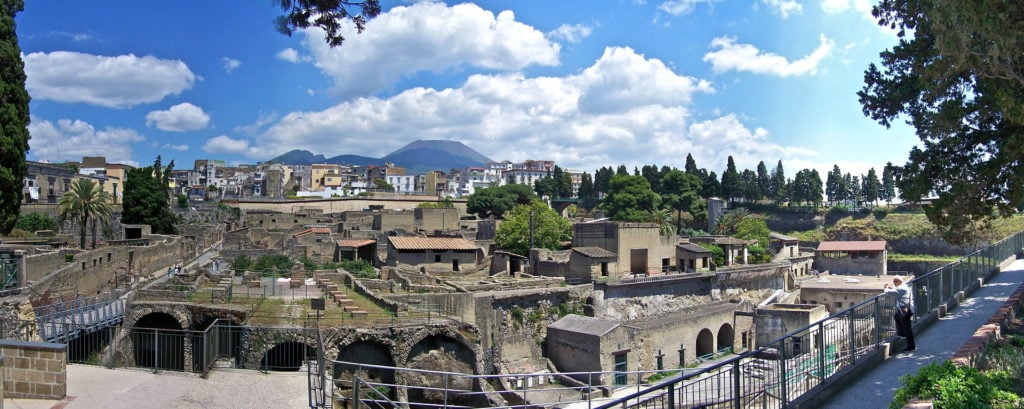
The skeleton of a victim of the cataclysmic eruption of the Mt. Vesuvius volcano was found this week in Herculaneum, near Pompeii, representing the first such find in over 25 years.
Like its larger sister town, Herculaneum was also destroyed and buried in volcanic ash after the gigantic explosion that occurred in the year 79 outside Naples, encapsulating the town forever in a shroud that preserved scenes from ordinary life at that time.
The man’s skeleton was the first such remains to be found at the site in a quarter of a century, according to a report in Smithsonian Magazine.
Archaeologists say that the unfortunate man, believed to be in his early 40s, was running in an effort to flee the town along a stone wall near the waterfront in what was perhaps the final phase of the long-lasting eruption.
The ending of the eruption was marked by a violent release of gases and ash, as pyroclastic flows surged through the area, traveling much faster than anyone could outrun them, at 60 mph (100 km/h).
According to excavation director Francesco Sirano, in an interview with ANSA, the deadly miasma was approximately 930 degrees Fahrenheit (500 degrees Celsius).
“The last moments here were instant, but terrible,” Sirano remarked to reporters in his explanation of the discovery of the Herculaneum skeleton.
Herculaneum skeleton found near Mediterranean shore
The town of Herculaneum was situated between Mt. Vesuvius (visible in the distance in the above photo) and the Mediterranean, but it is even closer to the (still active) volcano than its more well-known sister city of Pompeii.
When the volcano began its paroxysms, the people of Herculaneum naturally fled toward the sea, hoping that in taking a boat away from shore they could escape the worst of the eruption.
However, the pyroclastic flow swept over them with such speed that no one was spared; in the 1980s and 1990s, archaeologists uncovered hundreds of skeletons of people who had tried to find refuge in boat sheds along the water, ostensibly waiting their turn to take a boat to somewhere safe.
Victims succumbed almost instantly
Scholars are still divided on just how the victims died but there was no easy way out in either Herculaneum or Pompeii, with people and animals succumbing nearly instantly from the extreme heat, suffocating volcanic ash — or even the traumatic injuries caused by falling buildings or other debris.
Herculaneum’s lava rock seawall along the beach was where the most recent victim was discovered. Instead of taking shelter in a boat shed, he was outside of one; but since there was a large carbonized wooden beam found near his body, the researchers believe he may have been killed by it as it fell.
There are few other clues as to who the man might have been — either a local resident who was trying to get to his own boat, or someone who was valiantly attempting to help others get to the water.
The team of archaeologists are planning to carefully remove the pieces of hardened ash that have functioned like a tomb around the Herculaneum skeleton and subsequently excavate the skeleton in a laboratory.
Pieces of metal — and even, incredibly, fabric — found near the skeleton could have been part of some kind of a tool bag or coin purse. Alternatively, the metal may also have been part of a weapon.
ANSA reports that the archaeologists will be studying the contents of the bag closely in hopes that its contents will tell them more about who the unfortunate victim once was, and what he prized so dearly that he brought it with him as he fled for his life.
See all the latest news from Greece and the world at Greekreporter.com. Contact our newsroom to report an update or send your story, photos and videos. Follow GR on Google News and subscribe here to our daily email!



